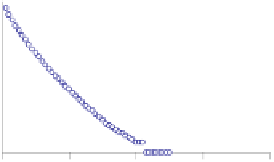Information Technology Reference
In-Depth Information
10
0
N
W
10
0
N
W
1000000
1000000
No Pathogen
Pathogen
No Pathogen
Pathogen
10
-2
10
-2
10000
10000
10
-4
10
-4
100
100
10
-6
10
-6
1
1
0
10
20
30
0
10
20
30
W
W
Fig. 5.
Distributions
N
τ
for a system with N=50 cells and 1 pathogenic cell with slightly
randomly changed ligands. Each case corresponds to a different pathogenic cell. All cells have
ILs given by (1), except that the position occupied by the pathogenic cell in the ILs have
randomly been displaced one position up or down. Even with this small difference the system is
able to perform self-nonself recognition, because several long lasting interactions emerge
involving the pathogenic cell.
Although in principle
P
and
P
*
can be similar, as happens in a kinetic proofreading
mechanism [2, 11, 12, 46, 47] this ratio can become significant because of the
exponent
, that accounts for the several steps required before any effector function
takes place. However here, contrary to what happens in conventional kinetic
proofreading mechanisms, a pre-defined sequence of interactions does not need to be
imposed. Rather, it emerges naturally from the frustrated dynamics. For this reason
we call this a generalization of the kinetic proofreading mechanism.
τ−1
10
0
N
W
167-167-167
237-127-127
1000000
{A}
{B}
{C}
10
-2
{B}
{C}
{A}
10000
{C}
{A}
{B}
10
-4
100
{A}
{B}
{C}
10
-6
1
0
20
40
60
80
W
Fig. 6.
A system with three distinct cell types or classes (
N=501
) and an IL constructed using a
structure analogous as in (1).
(Left)
Cells belonging to class A, have on the top of their ILs cells
from class B (specific cells within that class being randomly ordered), then those from class C
(randomly ordered), and at the bottom those from their own class (also randomly ordered).
(Right)
The distribution
N
τ
is approximately exponential in the absence of pathogens and when
the frequencies of each class of cell are adjusted to their equilibrium values (
N
A
=N
B
=N
C
=167
).
When one class of cells increases considerably relatively to the others (dark squares;
N
A
=237,
N
B
=N
C
=127
), long-lasting interactions are formed by cells from classes A and B. This result
shows the possibility of homeostatic control of the outgrowing population of cells. In this case,
cells from the self were seen as non-self.
Another important issue concerns the nature of the cells involved in the long-lived
interactions:
all
long-lived interactions involved a cell that ranked in top positions in
the IL of the pathogenic cell. Due to the requirement of frustration, the other cell must





























































